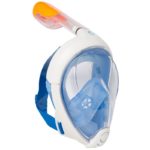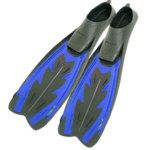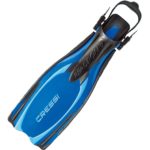Masks, snorkels, fins
Masks

Human faces come in all shapes and sizes, and so do masks. So the best advice we can give you is go to a dive shop and try on different masks.
You may be lucky and buy a mask over the internet that suits you, but it's very possible that the mask will leak, because it doesn't fit the shape of your face. If that happens, you'll hate snorkelling and you won't want to do it again. So, try masks on in a specialist shop.
A good dive shop will let you try on a number of different masks. The best way to try on a mask is to fold the strap back so you're not using it, and fit the mask over your face. Breathe in a little: if the mask seals over your face, then it's likely to be a good fit.
After you've tried a few, you'll know the difference between a mask that's suited to your face and one that isn't. You can buy a decent mask for about £40
Poor eyesight?

You can wear contact lenses under a mask. Obviously you'll need to talk to your optician before you do this, but Gill has a plain mask that she's had for thirty years, and she wears contact lenses when she snorkels.
She doesn't wear monthly lenses, because you can get water in your eyes and there's a risk of infection. So she wears daily lenses and throws them away at the end of the day.
Or you can buy prescription lenses for your mask. Not all masks do this - you'll need to ask the dive store which masks are compatible with prescription lenses - but once you've found the right mask, give your eye prescription to the dive shop, and your mask comes back with the equivalent of your spectacles fitted inside.
Price depends on the strength of your prescription: Steve is as blind as a bat, and his lenses cost about £60 each.
Full-face masks

This is a new idea for snorkellers over ten years of age. It's called the Easybreath, and it's designed to allow you to breathe through your nose and mouth..
It's a revolutionary product that is already getting good reviews - and selling at around £25, it's cheaper than buying a mask and snorkel separately - though there are some more expensive brands coming on the market.
We snorkelled with friends in April 2017, and they had these masks. They love them.
Visibility is good, you can breathe through your nose, and you don't have to put your mouth round a snorkel end.
We gave them a try, and thought they were fine: but we'll be keeping our current masks and snorkels for the moment. We're old school...
Snorkels

A snorkel is a tube that you use to suck air from above the water and carry it into your mouth below the water. It's as simple as that.
A soft mouthpiece is a good idea, and a band to attach to the strap of your mask.
We'd recommend one more thing. Many snorkels have 'purge valves' in them, which means the flexible part of the tube has a cul-de-sac attached to the mouthpiece with a one-way valve in it. If any stray water gets into the tube - and this can happen - then the water collects in the cul-de-sac, and you can blow it out through the valve without lifting your head above water.
A dry spit ("Ptchui") does the job admirably. A purge valve greatly enhances the snorkelling experience - our snorkels always have them.
The purge-valve snorkels are fine for us. You can buy one for about £20.
Slipper fins

Scuba divers don't like the word 'flipper', they prefer to call them 'fins' - you can call them what you like.
There are two types of fins - slipper fins and strap fins. Slipper fins are like shoes with webbed feet on the front - you slip your bare foot into the front part , and the ankle support grips your heel. You can't adjust them and they need to fit.
A snorkel or dive shop will usually rent these out, and you should try them. They are very comfortable if they're the right size: and they really improve your speed.
We used these when we were starting out, and we thought they were fine. They're quite large and bulky, though. We tend to take smaller strap fins with us now.
The best way to walk into water wearing fins is backwards: it means you trip up less. After a while you get used to them.
If you're snorkelling off a boat, put the fins on before you get in the water, and take them off before you get out. It makes it easier.
Strap fins

Strap fins are, um, a fin with a strap on. You put your bare foot (or your water shoe) - into the web compartment, and you make sure it doesn't fall off by tightening the strap.
These fins are good because you can tighten them round your foot: and you can also wear diving shoes inside them, so they work in cold weather.
Both types of fin have their advantages, as does not wearing a fin at all. Dive boats like snorkellers to wear fins, because they have more power when swimming: but we usually don't wear them.
We take small Cressi fins that stretch about six inches (15 cms) in front of our toes. The fact that we have our own fins tends to reassure boat owners.
Why do we prefer not to wear fins? The answer's simple - one of us gets tendonitis in the foot, and fins can aggravate this.

